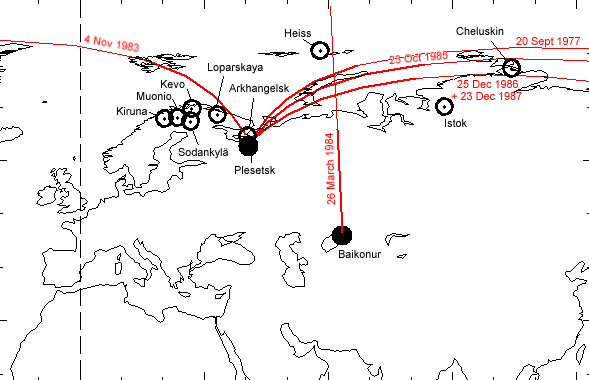
Optical observation of launches out of Plesetsk have often been reported in the media and is covered by an article at this site. However, professional organizations involved in geophysical research have often observed such launches by means of all-sky cameras and and even TV cameras. Luminous clouds that moved and expanded have been observed on several occasions by stations in the north of Scandinavia and Russia.
The present article discusses a particular report of such observations (1).
The direction of their movement has been determined by triangulation permitting the approximate launch azimuth to be estimated. Several of these observations have been correlated with known satellite launches out of Plesetsk. However, several launches have not been possible to connect to any known satellite launch so they must be related to missile tests of some kind. One of the observations concern a missile that seems to have been launched from Baikonur.
The table below summarizes
the launches observed from two or three points, any identified source and
my estimate as to the approximate inclination of the ground track, be it
a missile or satellite launch.
| Date | Time | Stations | Altitude | Source | Incl. | Launch site | Notes |
| 20 Sep 1977 | 0104-0112 UT | Loparskaya
Arkhangelsk Sodankylä |
230 km | Kosmos-955 | 81.2 | Plesetsk | "The Petrozavodsk phenomenon"
(see article by James Oberg) |
| 4 Nov 1983 | 0312-0320 UT | Loparskaya
Sodankylä Kevo |
250 km | - | 97 | Plesetsk | |
| 26 March 1984 | 2113-2118 UT | Loparskaya
Arkhangelsk Muonio |
1080 km | - | 90 | Baikonur | |
| 23 Oct 1985 | 0120-0132 UT | Loparskaya
Kiruna |
1050 km | - | 79 | Plesetsk | |
| 25 Dec 1986 | 1424-1431 UT | Loparskaya
Kevo |
530 km | - | 76 | Plesetsk | |
| 23 Dec 1987 | 1114-1119 UT | Heiss
Cheluskin Istok |
760 km | - | 76 | Plesetsk |
These cases are shown below. The 23 October 1985 flight path could very well be the same as for Kosmos-955, i.e. the 20 Sept. 1977. The graph in (1) is probable not more accurate than that. The 25 December 1986 and 23 December 1987 flight look like a satellite launch to 75.8 degrees inclination, but could of course very well be a missile launch.
The extraordinary missile launches are the two at unusual azimuths. The launch out of what appears to be Baikonur goes straight north. What could possibly be the purpose of such a launch? To provoke the BMEWS system and see how it reacted? The same could be the purpose of the "retrograde launch" out of Plesetsk on 4 November 1983. But where did these missiles impact. The retrograde path out of Plesetsk has only been used by the Kosmos-3M for launching the Disaster Monitoring Constellation built by Surrey Satellite Ltd, that somehow convinced the Russians they could launch at that azimuth.
Jonathan McDowell (2)
has speculated that the Baikonur launch might have been a 15A11
"Perimetr" launch - there was one such launch on an unknown date in
1984 from Baikonur - which used an ICBM to carry an emergency rocketborne
command and control system, as was done in the US on some Minuteman launches.
The trajectory you show would have had good visibility from much of the
Soviet union, appropriate for such an emergency communications relay (the
idea was you launch one of these after US nukes have wiped out your normal
comms network).

In (1)
there is also a table of launches observed from a single observation point.
This table contains more identifications of the source of the light phenomena
than the table above:
| Date | Time | Station | Source | Notes |
| 20 March 1979 | 1855-1858 UT | Is. Golomyany | Meteor-2 | Site located at 79 N, 93 E |
| 31 March 1982 | 0312-0420 UT | Istok | Kosmos-1345 | |
| 25 Oct. 1985 | 0403-0409 UT | Kiruna | - | |
| 8 Jan. 1986 | 1135-1138 UT | Istok | Kosmos-1715 | |
| 19 Sept. 1986 | 2220-2245 UT | Arkhangelsk | - |
More work is needed to try to correlate all these observations with known launches of Soviet missiles and satellite launch vehicles.